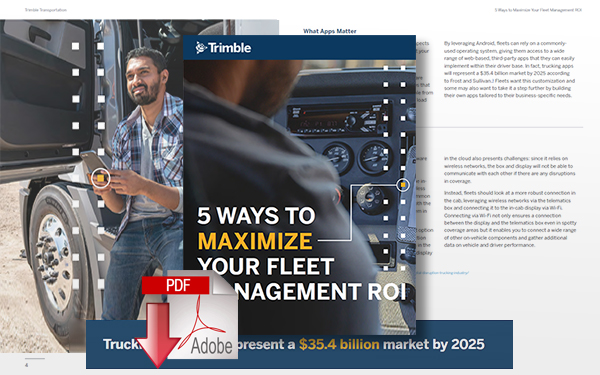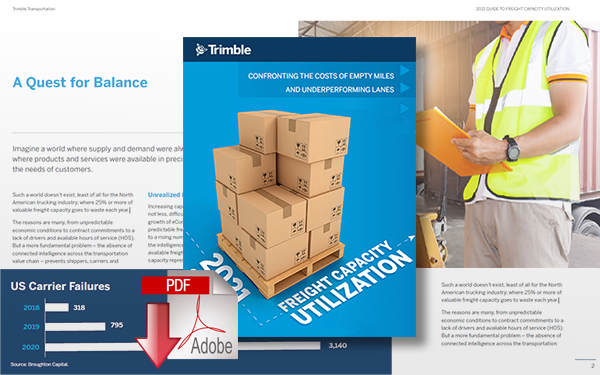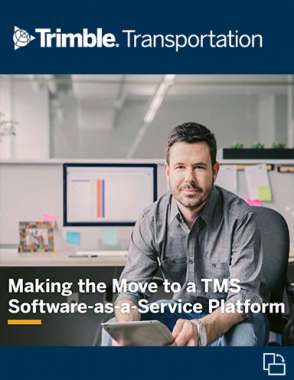4 Ways Technology Can Help Transportation Fleets Enhance the Driver Experience

For fleets of all shapes and sizes, their in-cab technology choices can play a crucial role in improving the driver experience and ultimately increasing productivity across their operations.
Driver Shortage and its Implications for the Trucking Industry
Last month, the American Trucking Associations (ATA) released an update to its “Truck Driver Shortage Analysis”, a comprehensive report that examines the ongoing driver shortage and its implications for the industry.
While the issue of recruiting and retaining drivers is nothing new, one of the report’s key takeaways is that the transportation industry could be short of roughly “100,000 drivers in five years and 160,000 drivers in 2028,” according to the ATA.
Watch the video (to the right): We Have A Shortage Of Truck Drivers – And The Problem Is Serious
This shortage has the potential to impact all aspects of the transportation supply chain, from broader effects on the time and cost to move freight to difficulties within individual fleets to find and keep drivers.
So, how can a carrier help combat this challenge - both for the sake of its business but for the industry as a whole?
For fleets of all shapes and sizes, their in-cab technology choices can play a crucial role in improving the driver experience and ultimately increasing productivity across their operations.
Here are a four recommended items to keep in mind when selecting technology to benefit your driver experience:
1. Give Them the Right Hardware
As is the case with consumer devices, there seems to be an endless amount of choice when it comes to displays and other in-cab equipment. When it comes to choosing the right options for your fleet, it is smart to consider any business or driver-specific requirements.
Do your drivers do work outside the cab that requires capturing electronic signatures? How about conducting electronic vehicle inspection reports? In these cases, the portability of a tablet may be better suited than a fixed-mount display.
How about where your fleet operates? Regardless of what kind of freight you haul, the trucking industry can sometimes create a rugged environment to operate in.
Do you have lanes in extreme weather conditions or in particularly tough conditions? If so, you may want to consider a ruggedized device that is built specifically for the rigors of the industry.
2. Optimize the User Experience
While the physical attributes of your equipment are important, so, too, is the operating system that your in-cab displays run on.
As consumer-grade devices become increasingly common in the trucking industry, mainstream operating systems like Android™ are now becoming the norm, in part because of their ability to enable a customized user experience.
According to Frost and Sullivan, trucking-centric apps will be a $35.4 billion market by 2025. For fleets like yours, this means providing drivers with a wide range of web-based, third-party apps, to help improve workflows and increase connectivity. You may also want to consider taking a step further and building your own apps tailored to your business-specific needs.
3. Go Beyond Fleet Management Basics
In addition to thinking about the hardware itself, it is equally important to consider what the hardware enables and how this can help you enhance the driver experience.
Certain items such as electronic logging (ELD), messaging and vehicle and driver data collection are a core part of any fleet management platform. Supplementing these standard capabilities with additional functionality can not only help your driver retention efforts but also help you achieve a greater return on your technology investment.
Some additional solutions worth considering include:
Video cameras and other safety-related technology: Adding in-dash cams that provide a view in and around your trucks can give you a neutral eyewitness perspective to your drivers’ experience on the road. Not only does this footage help improve driver liability protection in the event of an accident but can help pinpoint driver coaching opportunities and help improve the overall safety of your fleet.
Commercial in-cab navigation: It’s not just important to know the final destination of a load but how to get there. Adding in a commercial-grade in-cab navigation platform can enhance driver efficiency, reduce out-of-route miles and increase overall fuel economy.
Unlike consumer-focused solutions, commercial navigation is built for trucking, featuring guidance to commercial locations with truck entry and exit gates as well helping eliminate delays, unsafe driving conditions and dangerous vehicle maneuvers.
Electronic scanning and document management: No one likes paperwork but the process can be streamlined with an electronic scanning solution in the cab. Providing drivers with a scanning platform can help simplify the document management process, with barcode scanning and pre-filled data fields to make scanning documents easier and eliminate manual steps for drivers.
Weigh station bypass: Weigh station bypass programs help fleets with positive safety track records to potentially skip a weigh station along a route. The technology enables law enforcement to examine key data points, prompting inspection personnel to let safer fleets continue down the road and instead focus their efforts on potentially unsafe trucks or carriers.
For your transportation drivers, this means eliminating route delays, improved operational efficiencies, and more time moving down the 'logistics' road. By looking beyond the fleet management basics and taking a more holistic approach, you can help empower your drivers to reach new levels of safety and efficiency throughout their routes.
4. Set Up Training to Ensure Success
Like any technology, it’s only useful if you know how to use it. In-cab fleet management solutions are no different. Making your drivers comfortable with these tools is imperative to ensure they successfully adopt them and avoid being hindered by them.
When implementing new technology, consider:
Conducting onsite training: Rolling out new technology in phases can be beneficial to drivers. Identifying a pilot terminal to serve as beta testers for your new solutions can help, including exploring how the displays function and how to perform common tasks within the system.
Developing a library of resources: While initial training can go a long way in helping drivers, questions are likely to come up as they work within the new solutions. It is crucial that you supplement training with documentation and other self-serve resources to help answer common questions drivers might have.
Highlighting a framework for support: Even with extensive training and a vast collection of self-serve resources, questions will still come up. It is smart to anticipate these questions and develop a framework to address them.
What does your fleet management vendor’s support system look like? Who should your drivers call when issues arise?
Make sure they can provide you and your drivers with support when they need it, both through a dedicated support team available 24/7/365 and via a team of Customer Success Managers.
They say knowledge is power and having the right information will go a long way to helping your drivers harness technology to better their experience.
Discover Additional Tips to Support Your Drivers
Looking for more practical advice on making your drivers’ lives easier, both for retention and recruitment but to maximize your fleet’s performance? Check out Trimble’s Supply Chain in.sights, a virtual series of complimentary educational events centered on elevating your perspective of the transportation supply chain.
Our latest series of sessions are now on-demand and focused on the driver experience. Register Today (it's FREE) to get your business on the road to a happier driver base and more productive fleet.
Related Resources
5 Ways to Maximizing Your Fleet Management ROI
This informative and educational guide showcases five key considerations to ensure you get the most out of your fleet management technology - both for your needs today but in anticipation of your needs in the months and years ahead. Download Now!
2021 Guide to Freight Capacity Utilization
This guide is a handy reference covering year-over-year changes in retail and eCommerce sales and what influences those changes could have on your strategies, objectives and goals. Download Now!
More Resources from Trimble
Article Topics
Trimble News & Resources
Trimble acquires Transporean in major deal, for nearly $2 billion Transportation & Logistics Companies Gain Significant Benefits from Technology Investments Making the Move to a Transportation Management System Software-as-a-Service Platform 4 Reasons Your Fleet Needs Video Technology Guide to Maximizing Your Fleet Management ROI Connected Maintenance and its Role in the Supply Chain Mitigating Risk and Improving Trucking Safety with Enhanced Video Intelligence More TrimbleLatest in Transportation
Ask an Expert: How Shippers Can Prep for Hurricane Season UPS Struggles in First Quarter With Steep Earnings Decline FedEx Announces Plans to Shut Down Four Facilities The Two Most Important Factors in Last-Mile Delivery Most Companies Unprepared For Supply Chain Emergency Baltimore Bridge Collapse: Impact on Freight Navigating Amazon Logistics’ Growth Shakes Up Shipping Industry in 2023 More Transportation

















